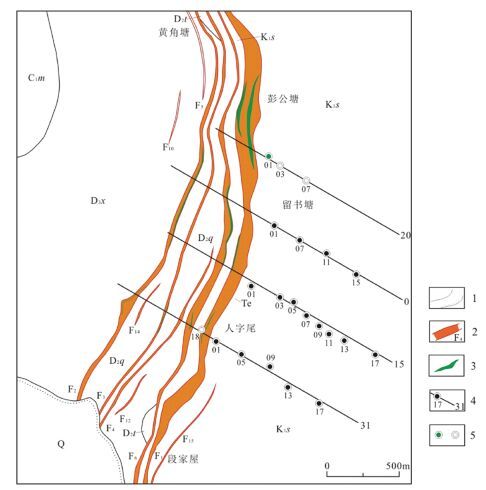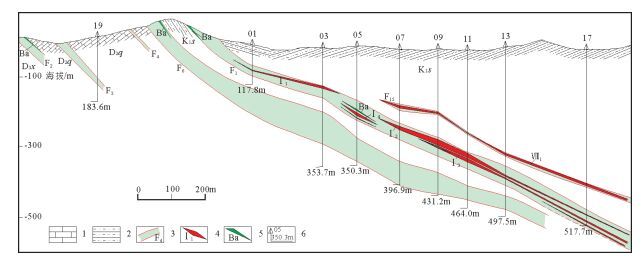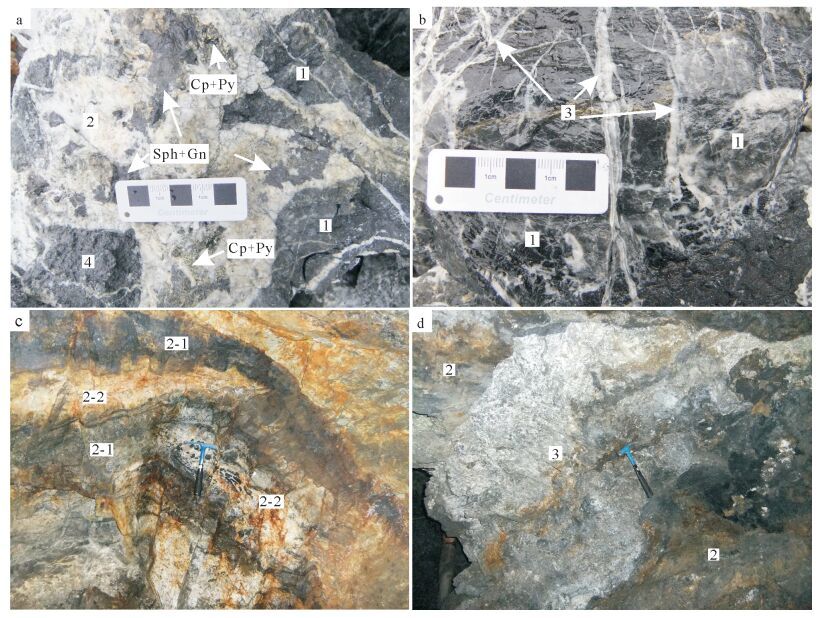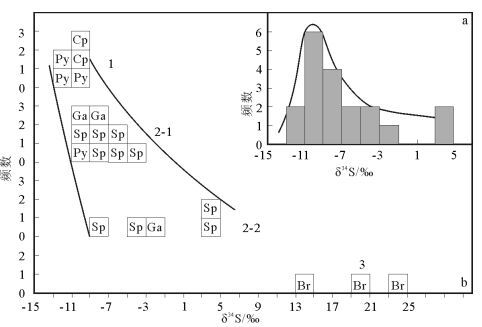Sulfur and lead isotope geochemistry of the Liushutang lead-zinc deposit in Hu'nan Province and its significance
-
摘要:
对湖南省留书塘铅锌矿床不同阶段矿石硫化物进行的S、Pb同位素研究表明,17件矿石样品硫化物的S同位素组成变化范围较宽(δ34S=-12.8‰~4.6‰),具有地层有机硫(约-13‰)与岩浆硫(约5‰)混合特征。从早阶段到晚阶段,硫化物呈现出δ34S值逐渐升高、极差逐渐增大的演化趋势。最晚形成的重晶石矿石硫由地层硫酸盐提供。13件硫化物样品的Pb同位素组成比较稳定,206Pb/204Pb、207Pb/204Pb、208Pb/204Pb值变化范围分别为18.627~18.942、15.670~15.804和38.366~38.912,平均值分别为18.747、15.705和38.614。与区内新元古界—寒武系基底、邻区湘南与铅锌矿相关的岩浆岩钾长石Pb同位素进行的对比表明,矿石铅主要来源于矿区深部岩浆岩,少部分可能来自于基底寒武纪地层。结合宏观地质特征分析,留书塘矿床可能是与岩浆岩有关的热液充填交代矿床,其成矿物质具有多来源特征。
Abstract:The discovery of the Liushutang lead-zinc deposit is one of the major breakthroughs of prospecting in the Nanling metal-logenic belt in recent years.The lead-zinc lodes are strictly controlled by the shattered fracture zones along the western margin of Hengyang basin.Field observation shows that the related mineralization can be divided into three stages of quartz-pyrite, quartzsphalerite-galena and barite.In this paper, systematic research on S, Pb isotopes based on different stages of ores were conducted to explain the origin of ore-forming materials and ore genesis.The result shows that sulfur isotopes of 17 sulfide samples vary in a wide range (δ34S value being-12.8‰~4.6‰) with a dynamic evolution of gradual increasing of δ34S values from early to late.This can be probably explained by a mixing process of organic sulfur (~-13‰) and magmatic sulfur (~5‰).Sulfur of latest barite ore (δ34S is 14.7‰~24.4‰) might have been provided by the strata sulfate.206Pb/204Pb, 207Pb/204Pb, 208Pb/204Pb ratios of 13 sulfide ore samples vary in the range of 18.627~18.942, 15.670~15.804 and 38.366~38.912, with the average value being 18.747, 15.705 and 38.614, respec-tively.These values are very similar to values of Pb isotopes of magmatic feldspar in southern Hu'nan and also have weak linear rela-tion with Pb isotopes of regional Cambrian strata, suggesting that ore materials might have mainly originated from magmatic pluton in the depth, and subordinately from the Cambrian strata.Based on the above results and geological evidence, the authors put forward a model of magma-related hydrothermal mineralization with multiple sources of ore-forming materials, which may be suitable for explaining the ore genesis of the Liushutang deposit.
-
Keywords:
- lead-zinc deposit /
- mineral paragenesis /
- S isotope /
- Pb isotope /
- Liushutang /
- Hu'nan Province
-
致谢: 中国地质调查局武汉地质调查中心李华芹研究员、中国地质大学(武汉)凌文黎教授对本文修改提出了许多宝贵意见,武汉地质调查中心蔡应雄工程师在成文过程中提供了较多帮助,在此表示诚挚的感谢。
-
图 1 衡阳盆地及周边地区地质矿产简图(据参考文献[19]修改)
1—不整合地质界线;2—整合地质界线;3—断裂;4—基底断裂或深大断裂;5—花岗质侵入体;6—铅锌矿;7—铜矿;8—铜铅锌矿。Pt3—新元古界;Z-S—震旦系-志留系;D-T2—泥盆系-中三叠统;K-N—白垩系-新近系。a—株洲-双牌深大断裂带;b—邵阳-郴州基底断裂带;c—醴陵-宁远深大断裂;d—常德-安仁基底断裂带
Figure 1. Geological map of Hengyang basin and adjacent areas showing distribution of mineral resources
图 2 湖南省留书塘铅锌矿床矿区地质略图(据参考文献②修改)
1—整合/不整合地质界线;2—断裂破碎带及编号;3—重晶石矿体;4—勘探线及见矿铅锌钻孔;5—见矿重晶石/未见矿钻孔。Q—第四系;K1s—白垩系神皇山组;C1m—石炭系孟公坳组;D3x—泥盆系锡矿山组;D2q—棋梓桥组;D2t—跳马涧组
Figure 2. Simplified geological map of the Liushutang lead-zinc deposit
图 6 留书塘矿床矿石矿物206Pb/204Pb-207Pb/204Pb(a)和206Pb/204Pb-208Pb/204Pb(b)图解(底图据参考文献[25])
A—地幔铅演化曲线;B—造山带铅演化曲线;C—上地壳铅演化曲线;D—下地壳铅演化曲线。1—矿石铅;2—奥陶系;3—寒武系;4—新元古界基底[23-24];5—湘南地区与铅锌矿相关的花岗岩钾长石[22]
Figure 6. 206Pb/204Pb-207Pb/204Pb (a) and 206Pb/204Pb-208Pb/204Pb (b) diagrams for sulfides from the Liushutang deposit
表 1 留书塘铅锌矿床主要原生矿物生成顺序
Table 1 The mineral paragenesis in the Liushutang Pb-Zn deposit
成岩成矿期成矿阶段 热液期 石英-黄铁矿阶段 石英-闪锌矿-方铅矿阶段 重晶石阶段 石英 
黄铁矿 黄铜矿 矿物名称 磁黄铁矿 闪锌矿 方铅矿 斑铜矿 辉银矿 重晶石 方解石 注:线条粗、细分别代表形成矿物的多、少;线条的长、短代表延续时间的长、短 表 2 留书塘矿床代表性矿石矿物S同位素组成
Table 2 S isotopic compositions of typical sulfides from the Liushutang deposit
样品号 采样位置 成矿阶段 测试矿物 δ34SCDT/% 12D128-1 四中段 2-2 闪锌矿 -7.5 12D128-2 四中段 2-1 闪锌矿 -8.1 四中段 黄铁矿 -10.8 12D128-3 四中段 2-2 闪锌矿 -4.5 12D128-4 四中段 2-1 闪锌矿 -5.0 12D128-5 四中段 2-1 闪锌矿 -10.0 12D129-1 五中段 3 重晶石 19.4 12D129-4 五中段 2-2 闪锌矿 4.6 12D130-2 六中段 1 黄铁矿 -12.8 12D130-3 六中段 1 黄铁矿 -12.0 12D130-4 六中段 2-1 闪锌矿 -3.8 12D130-5 六中段 3 重晶石 14.7 12D131-1 十三中段 2-1 方铅矿 -7.6 12D131-2 十三中段 2-1 闪锌矿 -5.4 12D131-3 十三中段 2-2 闪锌矿 4.1 方铅矿 -2.5 12D131-4 十三中段 2-1 闪锌矿 -7.1 方铅矿 -10.2 12D131-5 十三中段 1 黄铜矿 -9.3 12D131-6 十三中段 1 黄铁矿 -10.7 12D131-7 十三中段 1 黄铜矿 -9.9 12D131-8 十三中段 3 重晶石 24.4 注:1代表石英-黄铁矿阶段;2-1代表石英-闪锌矿-方铅矿阶段稍早形成的细粒铅锌矿石;2-2代表同阶段稍晚形成的粗粒矿石;3代表重晶石阶段 表 3 留书塘矿床代表性矿石矿物Pb同位素组成
Table 3 Pb isotopic compositions of typical sulfides from the Liushutang deposit
样品号 成矿阶段/地层/岩体 测试矿物/岩性 206Pb/204Pb 2σ 207Pb/204Pb 2σ 208Pb/204Pb 2σ 资料来源 12D128-2 2-1 闪锌矿 18.627 0.003 15.685 0.003 38.655 0.007 12D128-3 2-2 闪锌矿 18.719 0.002 15.677 0.002 38.519 0.004 12D128-5 2-1 闪锌矿 18.727 0.002 15.720 0.001 38.706 0.004 12D129-1 3 重晶石 18.629 0.002 15.681 0.002 38.630 0.005 12D129-4 2-2 闪锌矿 18.825 0.002 15.670 0.001 38.414 0.004 12D130-2 1 黄铁矿 18.709 0.002 15.703 0.001 38.650 0.004 12D130-3 1 黄铁矿 18.628 0.002 15.682 0.001 38.646 0.004 本文 12D130-5 3 重晶石 18.743 0.022 15.743 0.016 38.747 0.046 12D131-3 2-2 方铅矿 18.705 0.002 15.693 0.002 38.564 0.005 12D131-4 2-1 方铅矿 18.893 0.001 15.680 0.002 38.366 0.002 12D131-5 1 黄铜矿 18.942 0.002 15.711 0.002 38.484 0.006 12D131-6 1 黄铁矿 18.858 0.002 15.804 0.002 38.912 0.005 12D131-8 3 重晶石 18.708 0.002 15.716 0.002 38.683 0.005 14D04 奥陶系 板岩 19.031 0.004 15.708 0.004 40.639 0.008 本文 14D05 粉砂岩 18.911 0.002 15.781 0.002 39.670 0.006 14D08 粉砂岩 18.898 0.003 15.659 0.003 38.478 0.007 14D09 寒武系 板岩 21.106 0.003 15.895 0.002 38.959 0.005 本文 14D10 粉砂岩 19.347 0.004 15.697 0.004 38.778 0.010 14D11 粉砂质板岩 18.651 0.003 15.695 0.001 39.487 0.005 14D12 板岩 18.721 0.003 15.695 0.003 39.609 0.006 14D13 奥陶系 板岩 19.156 0.003 15.724 0.002 40.026 0.005 本文 14D15 板岩 18.811 0.003 15.702 0.002 39.392 0.005 14D16 板岩 18.907 0.004 15.690 0.003 40.059 0.008 309-12 钾长石 18.519 15.589 38.454 273-53 黄沙坪 钾长石 18.622 15.600 38.572 [17] 273-23 钾长石 18.657 15.675 38.438 273-19 钾长石 19.305 15.905 38.807 D137-1 铜山岭 钾长石 18.704 15.721 38.943 [17] D139-1 钾长石 18.805 15.726 38.987 水83-7 水口山 钾长石 18.400 15.630 38.484 [17] 水83-12 钾长石 18.534 15.682 38.583 注:成矿阶段1、2-1、2-2、3含义同表 2 -
金荣龙.湖南南部主要铅锌矿床硫铅同位素、矿物包裹体特点及在找矿评价中的应用[J].地质与勘探, 1986, 22(12):29-35. http://www.cnki.com.cn/Article/CJFDTOTAL-DZKT198612006.htm 龙汉春.铜山岭多金属矿床的成因特点和矿质来源[J].大地构造与成矿学, 1983, 7(3):198-208. http://www.cnki.com.cn/Article/CJFDTOTAL-DGYK198303001.htm 童潜明, 伍仁和, 彭季来.郴桂地区钨锡铅锌金银矿床成矿规律[M].北京:地质出版, 1995, 1-98. 王岳军, 范蔚茗, 郭锋, 等.湘东南中生代花岗闪长岩锆石U-Pb法定年及其成因指示[J].中国科学(D辑), 2001, 31(9):745-751. http://www.cnki.com.cn/Article/CJFDTOTAL-JDXK200109005.htm 王岳军, 范蔚茗, 郭峰, 等.湘南中生代花岗闪长质小岩体的岩石地球化学特征[J].岩石学报, 2001, 17(1):169-175. http://www.cnki.com.cn/Article/CJFDTOTAL-YSXB200101017.htm 姚军明. 湘南两类花岗岩及其成矿作用研究——以宝山和黄沙坪为例[D]. 南京大学博学位士论文, 2006: 1-103. 郭春丽, 许以明, 楼法生, 等.钦杭带侏罗纪与铜和锡矿有关的两类花岗岩对比及动力学背景探讨[J].岩石矿物学杂志, 2013, 32(4):463-484. http://www.cnki.com.cn/Article/CJFDTOTAL-YSKW201304005.htm 路睿. 湖南省常宁市水口山铅锌矿床地质特征及成因机制探讨[D]. 南京大学硕士学位论文, 2013: 1-59. 谢银财. 湘南宝山铅锌多金属矿区花岗闪长斑岩成因及成矿物质来源研究[D]. 南京大学硕士学位论文, 2013: 1-59. 周荣文, 龙国中.祁东留书塘铅锌矿地质特征及资源远景预测[J].湖南地质, 2001, 20(2):111-113. http://www.cnki.com.cn/Article/CJFDTOTAL-HNDZ200102008.htm 蔡新华, 陈民苏, 张厚宏, 等.留书塘铅锌矿矿床特征及资源量预测[J].地质与勘探, 2005, 41(5):5-9. http://www.cnki.com.cn/Article/CJFDTOTAL-DZKT200505001.htm 谭海明.湖南留书塘多金属矿地质特征及找矿远景分析[J].矿业快报, 2006, 443(5):53-54. http://www.cnki.com.cn/Article/CJFDTOTAL-KYKB200605020.htm 吴志华, 魏绍六.留书塘铅锌矿床成矿特征与找矿方向.华南地质与矿产, 2009, 4:17-21. doi: 10.3969/j.issn.1007-3701.2009.04.003 Seal R R. Sulfur isotope geochemistry of sulfide Minerals(Ⅱ)[J]. Reviews in Mineralogy and Geochemistry, 2006, 61:633-677. doi: 10.2138/rmg.2006.61.12
Mortensen J K, Hall B V, Bissig T. Age and paleotectonic setting of volcanogenic massive Sulfide deposits in the Guerrero Terrane of central Mexico:Constraints from U-Pb age and Pb isotope studies[J]. Economic Geology, 2008, 103:117-140. doi: 10.2113/gsecongeo.103.1.117
Basuki N I, Taylor B E, Spooner E T C. Sulfur isotope evidence for thermochemical reduction of dissolved sulfate in Mississippi Val-ley-Type zinc-lead mineralization, Bongara area, northern Peru[J]. Economic Geology, 2008, 103:783-799. doi: 10.2113/gsecongeo.103.4.783
王东升, 刘俊来, Tran M D, 等.越南东北部佐田铅锌矿床硫化物S、Pb同位素特征及其地质意义[J].地球化学, 2015, 34(4):757-768. http://www.cnki.com.cn/Article/CJFDTOTAL-ZQYD201504015.htm 刘训, 付德荣.湖南衡阳盆地沉积相及构造发展的若干问题[J].中国地质科学院院报, 1986, 13:13-36. http://www.cnki.com.cn/Article/CJFDTOTAL-DQXB198602001.htm 李福顺.钦杭成矿带衡阳盆地找矿方向及前景分析[J].华南地质与矿产, 2012, 4:360-368. doi: 10.3969/j.issn.1007-3701.2012.04.010 龙国中, 王积廉.衡阳盆地盐类矿床地质特征与矿床成因[J].湖南地质, 1994, 13(1):22-24. http://www.cnki.com.cn/Article/CJFDTOTAL-HNDZ401.004.htm Ohmoto H. Systematics of sulfur and carbon isotopes in hydrother-mal ore deposits[J]. Economic Geology, 1972, 67:551-578. doi: 10.2113/gsecongeo.67.5.551
伍光英. 湘东南多金属矿集区燕山期花岗岩类及其大规模成矿作用[D]. 中国地质大学(北京)博士学位论文, 2005: 132-133. 梁华英.龙山金锑矿床成矿物质来源研究[J].矿床地质, 1989, 8(4):39-48. http://www.cnki.com.cn/Article/CJFDTOTAL-KCDZ198904004.htm 刘海臣, 朱炳泉.湘西板溪群及冷家溪群的时代研究[J].科学通报, 1994, 39(2):148-150. http://www.cnki.com.cn/Article/CJFDTOTAL-KXTB199402015.htm Zartman R E, Doe B R. Plumbotectonics the model[J]. Tectono-physics, 1981, 75:135-162. doi: 10.1016/0040-1951(81)90213-4
Ohmoto H. Stable isotope geochemistry of ore deposits[J]. Re-views in Mineralogy and Geochemistry, 1986, 16:491-559. https://www.researchgate.net/publication/281981182_Stable_isotope_geochemistry_of_ore_deposits
赵焕升. 湖南桂阳宝山硫化铅锌矿床地球化学特征及伴生金、银地球化学演化规律[D]. 中南工业大学博士学位论文, 1990: 1-96. 刘悟辉, 徐文炘, 戴塔根, 等.湖南柿竹园钨锡多金属矿田野鸡尾矿床同位素地球化学研究[J].岩石学报, 2006, 22(10):2517-2524. doi: 10.3969/j.issn.1000-0569.2006.10.012 周涛, 刘悟辉, 李蘅, 等.湖南香花岭锡多金属矿床同位素地球化学研究[J].地球学报, 2008, 29(6):703-708. http://www.cnki.com.cn/Article/CJFDTOTAL-DQXB200806008.htm Strauss H. The isotopic composition of sedimentary sulfur through time[J]. Palaeogeogr. Palaeoclim. Paleoecol., 1997, 132:97-118. doi: 10.1016/S0031-0182(97)00067-9
Kampschulte A, Strauss H. The sulfur isotopic evolution of Pha-nerozoic seawater based on the analysis of structurally substituted sulfate in carbonates[J]. Chemical Geology, 2004, (3/4):255-286. https://www.researchgate.net/profile/A_Kampschulte/publication/222299197_The_sulfur_isotopic_evolution_of_Phanerozoic_seawater_based_on_the_analysis_of_structurally_substituted_sulfate_in_carbonates/links/568a42c008ae1e63f1fbb498.pdf?origin=publication_detail
Paytan A, Kastner M, Campbell D, et al. Seawater sulfur isotope fluctuations in the cretaceous[J]. Science, 2004, 304:1663-1665. doi: 10.1126/science.1095258
Panneerselvam K, Wacfarlane A W, Salters V J M. Provenance of ore metals in base and precious metal deposits of central Idaho as in-ferred from lead isotopes[J]. Economic Geology, 2006, 101:1063-1077. doi: 10.2113/gsecongeo.101.5.1063
祝新友, 王莉娟, 朱谷昌.锡铁山SEDEX铅锌矿床成矿物质来源研究——铅同位素地球化学证据[J].中国地质, 2010, 37(6):1682-1689. http://www.cnki.com.cn/Article/CJFDTOTAL-DIZI201006015.htm 张乾, 潘家永, 邵树勋.中国某些金属矿床矿石铅来源的铅同位素诠释[J].地球化学, 2000, 29(3):31-238. http://www.cnki.com.cn/Article/CJFDTOTAL-DQHX200003003.htm 戴自希, 盛继福, 白冶, 等.世界铅锌资源的分布与潜力[M].北京:地震出版社, 2005:9. 林孝先, 侯中健.试论中国铅锌矿矿床类型划分[J].桂林理工大学学报, 2014, 34(1):8-14. http://www.cnki.com.cn/Article/CJFDTOTAL-GLGX201401002.htm 湖南省地质调查院. 湖南衡阳盆地铅锌多金属矿评价成果报告. 2005. 湖南地质矿产开发局417队. 湖南省祁东县留书塘矿区大岭矿段铅锌矿详查报告. 2014.




 下载:
下载:





